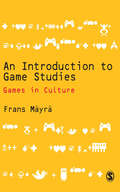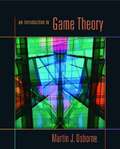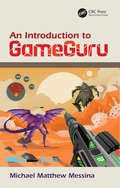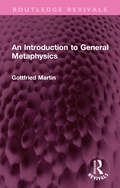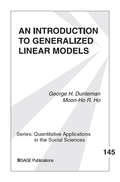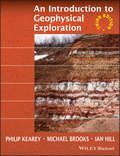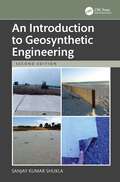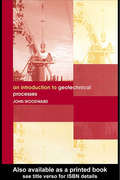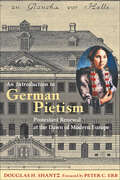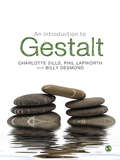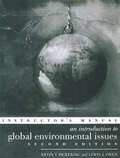- Table View
- List View
An Introduction to Fuzzy Linear Programming Problems: Theory, Methods and Applications (Studies in Fuzziness and Soft Computing #340)
by Amit Kumar Jagdeep KaurThe book presents a snapshot of the state of the art in the field of fully fuzzy linear programming. The main focus is on showing current methods for finding the fuzzy optimal solution of fully fuzzy linear programming problems in which all the parameters and decision variables are represented by non-negative fuzzy numbers. It presents new methods developed by the authors, as well as existing methods developed by others, and their application to real-world problems, including fuzzy transportation problems. Moreover, it compares the outcomes of the different methods and discusses their advantages/disadvantages. As the first work to collect at one place the most important methods for solving fuzzy linear programming problems, the book represents a useful reference guide for students and researchers, providing them with the necessary theoretical and practical knowledge to deal with linear programming problems under uncertainty.
An Introduction to GLBT Family Studies
by J Jerry BignerGain a better understanding of the special therapeutic issues and needs of GLBT familiesIn terms of research, GLBT families constitute a neglected segment of society. Gender and sexual orientation can make the issues in family studies even more difficult to work through. An Introduction to GLBT Family Studies tackles a challenging research topic by presenting noted experts examining the latest information on the newest type of family studies-GLBT families. This groundbreaking text explores a wide range of unique problems faced by nontraditional families, as well as issues common to traditional families that need to be approached with a GLBT perspective.Though homophobia and heterosexism constantly influence GLBT families, these factors do not necessarily overwhelm the dynamic of their basic family unit. Issues present in many traditional families are found when researching GLBT families. An Introduction to GLBT Family Studies spotlights the issues, research, and future trends that provide a foundation for the study of GLBT families. This breakthrough volume focuses not only on the obvious unique factors within GLBT families, but also on the elements encountered within families that are present regardless of sexual orientation and gender, such as physical and emotional abuse. Expert contributors present research findings on family pattern issues relating to parent-child relationships, child development, sibling relationships, family structure, intimate relationships, stepfamilies, alternative family structures, and extended family relationships. Each chapter is extensively referenced and offers possibilities for further research. An Introduction to GLBT Family Studies discusses family studies topics such as: the impact of the family of origin life course perspective transgender identity issues and the family when a spouse comes out as gay, lesbian, or bisexual a study of lesbian couples adapting genogram techniques in therapy research comparing siblings of different sexual orientations studies of patterns of responses to parental reactions to learning their offspring are gay, lesbian, or bisexual the polyamory structure to some gay men&’s familial relationships same-sex marriages and legalized relationships gay male couples&’ roles in today&’s society the impact of heterosexism on working with same-sex relationships research on long-term lesbian couplesAn Introduction to GLBT Family Studies is a valuable reference for academic researchers in family studies, marriage and family therapy, social work, and counseling; educators, upper division undergraduate and graduate students; and anyone interested in better understanding GLBT family studies.
An Introduction to GNSS Geodesy and Applications
by Clement A. OgajaThis volume is the second edition to 2022’s Introduction to GNSS Geodesy: Foundations of Precise Positioning Using Global Navigation Satellite Systems. It serves as an important reference to GNSS beginners as well as seasoned enthusiasts. In this updated edition, author Clement Ogaja focuses on fundamentals and contents that will remain unaffected by rapid changes and data exchange formats, ensuring that the book will remain up to date for years. The book consists of five chapters. The first covers basic concepts of parameter estimation in GNSS Geodesy. From there, Chapter 2 discusses reference systems in GNSS Geodesy. Chapter 3 moves on to observation models, errors, and biases, and Chapter 4, which is completely new to this second edition, details GNSS data processing workflow and strategies. The book concludes with an applied chapter that details concrete uses of GNSS Geodesy. New appendices that will be especially useful to seasoned users are also featured.
An Introduction to Game Studies
by Frans MayraAn Introduction to Game Studies is the first introductory textbook for students of game studies. It provides a conceptual overview of the cultural, social and economic significance of computer and video games and traces the history of game culture and the emergence of game studies as a field of research. Key concepts and theories are illustrated with discussion of games taken from different historical phases of game culture. Progressing from the simple, yet engaging gameplay of Pong and text-based adventure games to the complex virtual worlds of contemporary online games, the book guides students towards analytical appreciation and critical engagement with gaming and game studies. Students will learn to: - Understand and analyse different aspects of phenomena we recognise as 'game' and play' - Identify the key developments in digital game design through discussion of action in games of the 1970s, fiction and adventure in games of the 1980s, three-dimensionality in games of the 1990s, and social aspects of gameplay in contemporary online games - Understand games as dynamic systems of meaning-making - Interpret the context of games as 'culture' and subculture - Analyse the relationship between technology and interactivity and between 'game' and 'reality' - Situate games within the context of digital culture and the information society With further reading suggestions, images, exercises, online resources and a whole chapter devoted to preparing students to do their own game studies project, An Introduction to Game Studies is the complete toolkit for all students pursuing the study of games. The companion website at www.sagepub.co.uk/mayra contains slides and assignments that are suitable for self-study as well as for classroom use. Students will also benefit from online resources at www.gamestudiesbook.net, which will be regularly blogged and updated by the author. Professor Frans Mäyrä is a Professor of Games Studies and Digital Culture at the Hypermedia Laboratory in the University of Tampere, Finland.
An Introduction to Game Theory
by Martin J. OsborneAn Introduction to Game Theory, by Martin J. Osborne, presents the main principles of game theory and shows how they can be used to understand economic, social, political, and biological phenomena. The book introduces in an accessible manner the main ideas behind the theory rather than their mathematical expression. All concepts are defined precisely, and logical reasoning is used throughout. The book requires an understanding of basic mathematics but assumes no specific knowledge of economics, political science, or other social or behavioral sciences. <p><p>Coverage includes the fundamental concepts of strategic games, extensive games with perfect information, and coalitional games; the more advanced subjects of Bayesian games and extensive games with imperfect information; and the topics of repeated games, bargaining theory, evolutionary equilibrium, rationalizability, and maxminimization. The book offers a wide variety of illustrations from the social and behavioral sciences and more than 280 exercises. Each topic features examples that highlight theoretical points and illustrations that demonstrate how the theory may be used. Explaining the key concepts of game theory as simply as possible while maintaining complete precision, An Introduction to Game Theory is ideal for undergraduate and introductory graduate courses in game theory.
An Introduction to GameGuru
by Michael Matthew MessinaGame-Guru is an entry-level engine designed to be easy to use as well as being extremely accessible for the user. This book gives users the information needed to access the full depth of features available in the program. Details on how to perform more complex tasks are not found easily anywhere else or in any of the Game-Guru documentation. This book will cover all of the common topics including building levels, coding, AI and more. Key Features The only book the fully covers the Game-Guru engine Includes robust documentation to perform complex tasks that are not outlined anywhere else Includes level building, coding, AI and more Included are scripts and demo maps for readers to learn from An Introduction to Game Guru is the ultimate start-to-finish guide Michael is the Chief Linux Systems Engineer for a Fortune 500 company Includes many custom assets for your own project!
An Introduction to Gauge Theories
by Luciano Maiani Nicola Cabibbo Omar BenharWritten by world-leading experts in particle physics, this new book from Luciano Maiani and Omar Benhar, with contributions from the late Nicola Cabibbo, is based on Feynman’s path integrals. Key elements of gauge theories are described—Feynman diagrams, gauge-fixing, Faddeev-Popov ghosts—as well as renormalization in Quantum Electrodynamics. Quarks and QCD interactions are introduced. Renormalization group and high momentum behaviour of the coupling constants is discussed in QED and QCD, with asymptotic freedom derived at one-loop. These concepts are related to the Higgs boson and models of grand unification.
An Introduction to Gender and Wellbeing in Microeconomics: Foundations, Concepts and Policies
by Nicky PouwAn Introduction to Gender and Wellbeing in Microeconomics explains how to set up the basics of designing a gender-aware approach to microeconomics by constructing creative gender-aware indicators. Using a wellbeing economics framework, the book argues that economic models should take power differences such as those inherent with gender into account, and be complemented by more qualitative analysis geared to discovering the ‘how’ and ‘why’ behind the ‘what’ questions. This book will be essential reading for academic and professional researchers, as well as policy researchers in gender and economics, international development, and social and economic policy. It will be invaluable for courses relating gender to the economy, and will enable readers to get a clear and concise understanding of the gendered character of the economy and of economic policy.
An Introduction to General Metaphysics (Routledge Revivals)
by Gottfried MartinFirst published in 1961, An Introduction to General Metaphysics presents Gottfried Martin’s careful study of many of the passages in Plato and Aristotle which deal with metaphysical problems and in particular with the Platonic Theory of Ideas. He has traced the development of the theory both in early works and in late works such as the Parmenides and the Sophistes; and with equal care he has studied the relative passages in Aristotle’s Metaphysics. He has quoted many of these passages at length and has offered a careful account and analysis of the progress of Plato’s thought. He has also discussed in a very interesting way the main passages relative to Aristotle’s criticism of Plato’s Theory of Ideas. This book is a must read for any student of Greek Philosophy and Philosophy in general.
An Introduction to Generalized Linear Models (Chapman & Hall/CRC Texts in Statistical Science)
by Adrian G. Barnett Annette J. Dobson<p>An Introduction to Generalized Linear Models, Fourth Edition provides a cohesive framework for statistical modelling, with an emphasis on numerical and graphical methods. This new edition of a bestseller has been updated with new sections on non-linear associations, strategies for model selection, and a Postface on good statistical practice. <p>Like its predecessor, this edition presents the theoretical background of generalized linear models (GLMs) before focusing on methods for analyzing particular kinds of data. It covers Normal, Poisson, and Binomial distributions; linear regression models; classical estimation and model fitting methods; and frequentist methods of statistical inference. After forming this foundation, the authors explore multiple linear regression, analysis of variance (ANOVA), logistic regression, log-linear models, survival analysis, multilevel modeling, Bayesian models, and Markov chain Monte Carlo (MCMC) methods.</p>
An Introduction to Generalized Linear Models (Quantitative Applications in the Social Sciences)
by George Henry Dunteman Moon-Ho R. HoDo you have data that is not normally distributed and don′t know how to analyze it using generalized linear models (GLM)? Beginning with a discussion of fundamental statistical modeling concepts in a multiple regression framework, the authors extend these concepts to GLM (including Poisson regression. logistic regression, and proportional hazards models) and demonstrate the similarity of various regression models to GLM. Each procedure is illustrated using real life data sets, and the computer instructions and results will be presented for each example. Throughout the book, there is an emphasis on link functions and error distribution and how the model specifications translate into likelihood functions that can, through maximum likelihood estimation be used to estimate the regression parameters and their associated standard errors. This book provides readers with basic modeling principles that are applicable to a wide variety of situations.Key Features:- Provides an accessible but thorough introduction to GLM, exponential family distribution, and maximum likelihood estimation- Includes discussion on checking model adequacy and description on how to use SAS to fit GLM- Describes the connection between survival analysis and GLM This book is an ideal text for social science researchers who do not have a strong statistical background, but would like to learn more advanced techniques having taken an introductory course covering regression analysis.
An Introduction to Generative Drug Discovery (Drugs and the Pharmaceutical Sciences)
by Sean EkinsThis book focuses on the latest advances in computational de novo drug discovery methods, also known as generative drug discovery. This book describes the state‑of‑the‑art methods and applications for de novo design of drug candidates using generative chemistry models as well as the ethical aspects of this technology. It will provide a foundation for those new to the field as well as those that may already have some experience of its utility. With contributions from scientists in both academia and industry ‘an Introduction to Generative Drug Discovery’ may represent one of the earliest if not the first book to focus on this topic. This book focuses on the latest advances in generative discovery methods. This book will describe different state of the art applications of generative molecule design. The book describes ethical aspects of generative drug discovery technology. The mix of academic and industrial authors provides an array of applications of generative drug discovery. A future perspective of where these generative technologies may take us in drug discovery is described included self-driving labs.
An Introduction to Genetic Engineering
by Desmond S. T. NichollIn this third edition of his popular undergraduate-level textbook, Des Nicholl recognises that a sound grasp of basic principles is vital in any introduction to genetic engineering. Therefore, as well as being thoroughly updated, the book also retains its focus on the fundamental principles used in gene manipulation. The text is divided into three sections: Part I provides an introduction to the relevant basic molecular biology; Part II, the methods used to manipulate genes; and Part III, applications of the technology. There is a new chapter devoted to the emerging importance of bioinformatics as a distinct discipline. Other additional features include text boxes, which highlight important aspects of topics discussed, and chapter summaries, which include aims and learning outcomes. These, along with key word listings, concept maps and a glossary, will enable students to tailor their study to suit their own learning styles and ultimately gain a firm grasp of a subject that students traditionally find difficult.
An Introduction to Genetic Engineering (Studies In Biology Ser.)
by Desmond S. NichollThe fourth edition of this popular textbook retains its focus on the fundamental principles of gene manipulation, providing an accessible and broad-based introduction to the subject for beginning undergraduate students. It has been brought thoroughly up to date with new chapters on the story of DNA and genome editing, and new sections on bioethics, significant developments in sequencing technology and structural, functional and comparative genomics and proteomics, and the impact of transgenic plants. In addition to chapter summaries, learning objectives, concept maps, glossary and key word lists the book now also features new concluding sections, further reading lists and web-search activities for each chapter to provide a comprehensive suite of learning resources to help students develop a flexible and critical approach to the study of genetic engineering.
An Introduction to Genetics for Language Scientists: Current concepts, methods and findings
by Dan DediuDuring the last few decades we have discovered enormous amounts about our genomes, their evolution and, importantly for linguists and language scientists, the genetic foundations of language and speech. Accessible and readable, this introduction is designed specifically for students and researchers working in language and linguistics. It carefully focuses on the most relevant concepts, methods and findings in the genetics of language and speech, and covers a wide range of topics such as heritability, the molecular mechanisms through which genes influence our language, and the evolutionary forces affecting them. Filling a large gap in the literature, this essential guide explores relevant examples including hearing loss, stuttering, dyslexia, brain growth and development, as well as the normal range of variation. It also contains a helpful glossary of terms, and a wide range of references so the reader can pursue topics of interest in more depth.
An Introduction to Geographical and Urban Economics: A Spiky World
by Steven Brakman Harry Garretsen Charles van MarrewijkA comprehensive introduction to both urban and geographical economics: the two dominant approaches used to explain the distribution of economic activity across space. This fully revised and up-to-date third edition gives a full account of the ever-expanding body of knowledge and insights on urban and geographical economics, with an increased emphasis on analytical concepts and empirical methods, reflecting developments in the literature since the last edition. The authors provide both state-of-the-art theories and empirics, introducing new data, methods and models for this edition, including a whole chapter dedicated to measurement issues and empirical methods. Written in a style that is accessible to students who are new to the field, this textbook also includes more advanced concepts that will interest experienced researchers. Unrivalled in its scope and depth, this title is perfect for readers seeking to understand the uneven spatial distribution of economic activity between and within countries.
An Introduction to Geological Structures and Maps, Eighth Edition
by George M Bennison Paul A Olver Keith A MoseleyAn Introduction to Geological Structures and Maps is a concise and accessible textbook providing simple structural terminology and map problems which introduce geological structures. It is a perfect introduction to mapping for students of geology, engineering geology and civil engineering.Each topic is explained and illustrated by figures, and exercises follow on successive maps. If students are unable to complete an exercise, they can read on to obtain more specific instructions on how theory may be used to solve the problem. An appendix at the end of the book provides the solutions.This new, eighth edition contains simplified introductory matter to make the subject as easy to grasp as possible. Colour photographs illustrating geological structures bring the subject to life and a new map from the British Geological Survey illustrates a real area. There is more on outcrop patterns, which will help students to think in 3D, and on structures and the relationship of topography to geological structure. Cliff sections have been added to reinforce the concept of apparent dip. The section on planetary geology has been more closely tied to igneous geology to aid understanding of the connection between the two. Finally, a new map on economic geology has been added for the benefit of engineering students.A geological glossary helps students to understand and memorise key terms and a new, colourful, text design enlivens the appearance of this popular book.
An Introduction to Geophysical Exploration
by Michael Brooks Philip Kearey Ian HillThis new edition of the well-established Kearey and Brooks text is fully updated to reflect the important developments in geophysical methods since the production of the previous edition. The broad scope of previous editions is maintained, with even greater clarity of explanations from the revised text and extensively revised figures. Each of the major geophysical methods is treated systematically developing the theory behind the method and detailing the instrumentation, field data acquisition techniques, data processing and interpretation methods. The practical application of each method to such diverse exploration applications as petroleum, groundwater, engineering, environmental and forensic is shown by case histories. The mathematics required in order to understand the text is purposely kept to a minimum, so the book is suitable for courses taken in geophysics by all undergraduate students. It will also be of use to postgraduate students who might wish to include geophysics in their studies and to all professional geologists who wish to discover the breadth of the subject in connection with their own work.
An Introduction to Geosynthetic Engineering
by Sanjay Kumar ShuklaThe development of the use of polymeric materials in the form of geosynthetics has brought about major changes in the civil engineering industry. Geosynthetics are available in a wide range of compositions appropriate to different applications and environments. Over the past three to four decades, civil engineers have grown increasingly interested
An Introduction to Geosynthetic Engineering
by Sanjay Kumar ShuklaGeosynthetics, primarily made from synthetic polymers, provide efficient, cost-effective, and sustainable solutions for civil, geotechnical, and environmental challenges. Enhancing infrastructure performance with soil and rock, they are integral to global construction standards. Beyond civil engineering, their applications extend to mining, agriculture, and aquaculture. This book explores the principles, properties, and applications of geosynthetics, offering tailored solutions for innovative and sustainable infrastructure development.This updated second edition of An Introduction to Geosynthetic Engineering provides a comprehensive introduction to geosynthetics, meeting the needs of senior undergraduate and postgraduate students, practising engineers, and professionals. It includes expanded content, updated chapters, new sections, detailed site photographs, revised standards and guidelines, additional examples, and practice questions. Tailored to support both learning and practical application, this textbook is an essential resource for understanding and utilizing geosynthetics in sustainable infrastructure development.
An Introduction to Geotechnical Processes
by John WoodwardThe study of the solid part of the earth on which structures are built is an essential part of the training of a civil engineer. Geotechnical processes such as drilling, pumping and injection techniques enhance the viability of many construction processes by improving ground conditions.Highlighting the ground investigation necessary for the process
An Introduction to German Pietism: Protestant Renewal at the Dawn of Modern Europe (Young Center Books in Anabaptist and Pietist Studies)
by Douglas H. ShantzAn up-to-date portrait of a defining moment in the Christian story—its beginnings, worldview, and cultural significance.Winner of the Dale W. Brown Book Award of the Young Center for Anabaptists and Pietist Studies at Elizabethtown CollegeAn Introduction to German Pietism provides a scholarly investigation of a movement that changed the history of Protestantism. The Pietists can be credited with inspiring both Evangelicalism and modern individualism.Taking into account new discoveries in the field, Douglas H. Shantz focuses on features of Pietism that made it religiously and culturally significant. He discusses the social and religious roots of Pietism in earlier German Radicalism and situates Pietist beginnings in three cities: Frankfurt, Leipzig, and Halle. Shantz also examines the cultural worlds of the Pietists, including Pietism and gender, Pietists as readers and translators of the Bible, and Pietists as missionaries to the far reaches of the world. He not only considers Pietism's role in shaping modern western religion and culture but also reflects on the relevance of the Pietist religious paradigm of today.The first survey of German Pietism in English in forty years, An Introduction to German Pietism provides a narrative interpretation of the movement as a whole. The book's accessible tone and concise portrayal of an extensive and complex subject make it ideal for courses on early modern Christianity and German history. The book includes appendices with translations of German primary sources and discussion questions.
An Introduction to Gestalt
by Charlotte Sills Mr Phil Lapworth Billy DesmondThis thoroughly revised edition of Gestalt Counselling introduces the fundamental concepts of Gestalt and systematically demonstrates how to apply and use these in practice. Taking a relational perspective, the expert authors explore how Gestalt can be used in a wide variety of 'helping conversations' from counselling, psychotherapy and coaching to mentoring, managing, consulting and guiding. A Each chapter contains case examples from the therapeutic world and a 'running case study' featuring ongoing coaching work moves throughout the book, with diagrams and lists for further reading making this the ideal text for use in training. The accessible, engaging writing style will appeal to undergraduates and postgraduates alike. Charlotte Sills is a practitioner and supervisor in private practice, a tutor at Metanoia Institute and a tutor and supervisor of coaching at Ashridge CollegeBusiness School. She is the author or co-author of many books and articles on therapeutic work. Phil Lapworth is a counsellor, psychotherapist and supervisor in private practice near Bath and has written extensively in the field of counselling and psychotherapy. Billy Desmond is a Gestalt psychotherapist, executive coach and organisational development consultant. He is a member of Ashridge College and a Programme Director of Partnering and Consulting in ChangeHead of the Gestalt Department at Metanoia Insititute, and tutor and consultant at Ashridge Business School.
An Introduction to Ghosts: True Encounters With The World Beyond (True Encounters with the World Beyond #7)
by Hans HolzerJoin paranormal expert and storyteller extraordinaire Hans Holzer as he explores ghostly manifestations of every variety and delves into the true nature of the &“other side&”In this groundbreaking work, professor Hans Holzer provides a thorough introduction to the art and science of successful and lucid communication with the world beyond. Here he delves into the nature of life and death, shares invaluable information that every would-be ghost hunter should know, and explains the exact nature of what we understand to be a &“ghost.&”
An Introduction to Global Environmental Issues Instructors Manual
by Lewis A. Owen Professor Kevin PickeringAn Introduction to Global Environmental Issues presents a comprehensive stimulating introduction to the key environmental issues presently threatening our global environment. Offering an authoritative introduction to the key topics, a source of latest environmental information, and an innovative stimulus for debate, this is an essential book for all those studying or concerned with global environmental issues.In this second edition, the most topical global environmental issues are brought more clearly into focus. Explanations of the evolution of the earth's natural systems (hydrosphere, biosphere, geosphere, ecosphere) provide the essential understanding of the scientific concepts, processes and historical background behind key environmental issues. Contemporary socio-economic, cultural and political considerations are explored and important conceptual approaches such as Gaian hypotheses and Chaos Theory are introduced. Human impact and management of the natural environment, and concerns for maintaining biodiversity are emphasised throughout.Specific features include: Case studies drawn from across the world Superb illustrations: 4-colour plate sections; a wealth of informative diagrams Glossary of key terms, with key concepts highlighted throughout the text Annotated guides to Further Reading Chapter summaries and key points A new Instructors' Manual is available to accompany the text



